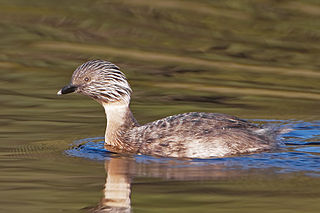Related Research Articles

Australia and its offshore islands and territories have 898 recorded bird species as of 2014. Of the recorded birds, 165 are considered vagrant or accidental visitors, of the remainder over 45% are classified as Australian endemics: found nowhere else on earth. It has been suggested that up to 10% of Australian bird species may go extinct by the year 2100 as a result of climate change.

The squirrel glider is a nocturnal gliding possum. The squirrel glider is one of the wrist-winged gliders of the genus Petaurus.

The hoary-headed grebe is a member of the grebe family. It breeds in southern parts of Australia; it winters throughout the island of Tasmania. The bird takes its name from the silvery-white streaking on its black head. It is common in Australia, with a population of about 500,000. Its habitat is similar to that of the Australasian grebe.
Clifford Brodie Frith is an Australian ornithologist and wildlife photographer. He and his wife Dawn Whyatt Frith have studied and published on Australian birds for many years, and publish books as Frith & Frith.

The yellow-bellied glider, also known as the fluffy glider, is an arboreal and nocturnal gliding possum that lives in native eucalypt forests in eastern Australia, from northern Queensland south to Victoria.

Swinhoe's snipe,, also known as forest snipe or Chinese snipe, is a medium-sized, long-billed, migratory wader.

The comb-crested jacana, also known as the lotusbird or lilytrotter, is the only species of jacana in the genus Irediparra. Like other jacana species, it is adapted to the floating vegetation of tropical freshwater wetlands.

The black-faced sheathbill, also known as the lesser sheathbill or paddy bird, is one of only two species of sheathbills, aberrant shorebirds which are terrestrial scavengers of subantarctic islands.

The oriental plover, also known as the oriental dotterel, is a medium-sized plover closely related to the Caspian plover. It breeds in parts of Mongolia and China, migrating southwards each year to spend its non-breeding season in Indonesia, New Guinea and northern Australia.

The red-kneed dotterel is a species of plover in a monotypic genus in the subfamily Vanellinae. It is often gregarious and will associate with other waders of its own and different species, even when nesting. It is nomadic and sometimes irruptive.
Western pebble-mound mouse or Ngadji is a burrowing and mound building rodent in the family Muridae. They occur in the Pilbara, a remote region in the northwest of Australia.

The rufous songlark is a species in the family Locustellidae endemic to Australia.
Eric Arthur Frederic Worrell (MBE), was an Australian naturalist, herpetologist, science writer and zoo founder and director, known for establishing the Australian Reptile Park at Wyoming on the NSW Central Coast in 1959.

A Field Guide to the Birds of Australia was first published in 1980 by Collins, Sydney. It was authored by Graham Pizzey with illustrations by Roy B. Doyle. The first edition was issued in octavo format, 220 mm in height by 140 mm width, with a foreword by D.L. Serventy. It contained 460 pages of text with 32 black-and-white and 56 colour plates illustrating nearly all species of birds recorded in Australia at the time of publication. The plates were bunched between pages 300 and 301, while there were 725 maps of breeding distribution on pages 411-442 between the main text and the indexes, as well as maps of Australia in the end papers. Its success was such that it was followed by several further editions.

The Reader's Digest Complete Book of Australian Birds is a book first published by Reader's Digest Services Pty Ltd of Sydney, Australia in 1976 and reprinted several times, with a completely revised edition issued in 1986.
Alfred Donald Trounson OAM was a British diplomat and amateur photographer who settled in Australia in his retirement to become a bird photographer and the founder of the National Photographic Index of Australian Wildlife.
Darrell John Kitchener is a biologist who has been active in mammalian research in Western Australia and Indonesia. He is the author of over one hundred papers, published while employed as the senior research biologist at the Western Australian Museum, and described many new species of mammals during his 28 years in that position. Kitchener was born on 9 June 1943 in Victoria, Australia. He obtained degrees in botany and zoological sciences at the University of Tasmania and completed his Ph.D. at the University of Western Australia. His works include contributions to the Australian Museum's Complete book of Australian mammals.

Triodia basedowii, commonly known as lobed spinifex, is a species of tussock-forming grass-like plant found in Australia.
Ronald Strahan (1922–2010) was a zoologist, historian and author of works on the fauna of Australia.
Furred Animals of Australia is a general reference book, first published in 1931, that gives accounts of Australian mammals, the continent's often unique marsupial and placental mammal fauna. The text and research for the book was undertaken by the mammologist and museum curator Ellis Le Geyt Troughton. Colour plates for the work were produced by Neville W. Cayley, whose popular standard guide What Bird is That? inspired Troughton's working title What Mammal is That?. The second edition of the work, while dated 1943 on the title page, was issued by Angus and Robertson in 1944. It remained the only authoritative treatment of the continent's mammals to be readily available during the mid-twentieth century.
References
Notes
Sources
- "National Photographic Index of Australian Wildlife". Selected Archival Holdings. Australian Museum. Retrieved 21 December 2009.
- Serventy, Vincent N., ed. (1982). The Wrens and Warblers of Australia. Sydney: Angus & Robertson. ISBN 0-207-14480-X.
- Strahan, Ronald, ed. (1987). The Shorebirds of Australia. Sydney: Angus & Robertson. ISBN 0-207-15348-5.
- Strahan, Ronald, ed. (1996). Finches, Bowerbirds and Other Passerines of Australia. Sydney: Angus & Robertson. ISBN 0-207-18880-7.